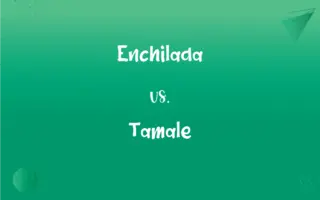Apterygota vs. Pterygota: What's the Difference?
Edited by Aimie Carlson || By Janet White || Published on February 6, 2024
Apterygota is a subclass of insects that never develop wings. Pterygota is a subclass of insects characterized by the presence of wings or winged ancestors.

Key Differences
Apterygota are a group of insects that are primitively wingless, meaning they do not develop wings at any stage of their life cycle. Pterygota, in contrast, encompasses the vast majority of insect species that either have wings or belong to a lineage that had winged ancestors.
Insects in the Apterygota group, such as silverfish and firebrats, typically show direct development, without undergoing metamorphosis. Pterygota insects, including butterflies, beetles, and bees, generally undergo metamorphosis, which in many species involves the development of wings.
Apterygota are often found in moist environments and have a simple life cycle. Pterygota, due to their ability to fly, have a more diverse range of habitats and often exhibit more complex behaviors and life cycles due to their mobility.
The body structure of Apterygota remains fairly consistent throughout their life, with minimal changes other than size. In Pterygota, the presence of wings often requires significant anatomical adaptations, especially in species undergoing complete metamorphosis.
Apterygota species are less common and less diverse compared to Pterygota. Pterygota encompasses the majority of known insect species, indicating a successful evolutionary adaptation in the form of wings.
ADVERTISEMENT
Comparison Chart
Wing Development
Do not develop wings
Have wings or winged ancestors
Metamorphosis
Usually direct development, no metamorphosis
Often undergo metamorphosis
Habitats
Mostly found in moist environments
Diverse range of habitats
Body Structure Changes
Minimal changes, primarily in size
Significant changes, especially in winged forms
Species Diversity
Less common and diverse
More diverse, majority of insect species
ADVERTISEMENT
Apterygota and Pterygota Definitions
Apterygota
A subclass of insects with direct development and no metamorphosis.
Firebrats, similar to silverfish, belong to the Apterygota group.
Pterygota
A subclass of insects with the ability to develop wings.
Beetles, part of the Pterygota group, display a wide variety of wing forms.
Apterygota
A group of insects primarily characterized by the absence of wings.
Insects in the Apterygota subclass are often overlooked due to their small size and hidden habitats.
Pterygota
Insects with adaptations for flight, including wing development.
The diverse world of bees falls under the Pterygota subclass.
Apterygota
Wingless insects with consistent body structure throughout their life.
Apterygota insects maintain a consistent body structure as they grow.
Pterygota
Insects that possess wings or descend from winged ancestors.
Butterflies are a beautiful example of Pterygota.
Apterygota
Primitive insects characterized by their lack of wings.
Apterygota species are often found in damp environments.
Pterygota
A large, diverse group of insects including all winged species.
Pterygota encompasses most of the commonly known insects like moths and flies.
Apterygota
Insects that never develop wings in their lifecycle.
Silverfish are a well-known example of Apterygota.
Pterygota
Winged insects, often undergoing significant metamorphosis.
Dragonflies are among the most ancient of Pterygota.
FAQs
What distinguishes Apterygota from Pterygota?
Apterygota are wingless insects, while Pterygota includes insects with wings or winged ancestors.
What are some examples of Apterygota?
Silverfish and firebrats are examples of Apterygota.
How do Apterygota adapt to their environment?
They often rely on their ability to hide and thrive in moist environments.
Do Apterygota undergo metamorphosis?
No, they typically have direct development without metamorphosis.
How does metamorphosis benefit Pterygota?
It allows adaptation to different life stages, often enhancing survival and reproduction.
Are all Pterygota capable of flight?
Most can fly, but some have lost this ability over evolutionary time.
Do Apterygota have a different reproductive strategy than Pterygota?
Their strategies vary, but lack of wings influences their mating and dispersal methods.
Can Pterygota insects be wingless?
Some Pterygota may be wingless but are descended from winged ancestors.
What roles do Pterygota play in the ecosystem?
They are pollinators, decomposers, and form a significant part of the food web.
Are Pterygota more diverse than Apterygota?
Yes, Pterygota are more diverse in terms of species and habitats.
What kind of metamorphosis do Pterygota insects undergo?
They undergo either complete or incomplete metamorphosis.
Are there any flying Apterygota?
No, Apterygota do not develop wings and therefore cannot fly.
How do Apterygota survive without wings?
They rely on their ability to hide and thrive in protected environments.
Are Apterygota found worldwide?
Yes, but they are more common in moist environments and less visible than Pterygota.
Is the lack of wings in Apterygota a disadvantage?
It limits their mobility, but they adapt well to their specific habitats.
What is the habitat preference for Apterygota?
They prefer damp, dark environments.
How do Apterygota contribute to their ecosystems?
They often play roles in decomposition and soil aeration.
Do all Pterygota have the same wing structure?
No, wing structure varies greatly among Pterygota.
What is the evolutionary significance of Pterygota?
The development of wings allowed for greater dispersal, adaptability, and evolutionary success.
Can Pterygota insects be found in aquatic environments?
Yes, many Pterygota, like dragonflies, have aquatic life stages.
About Author
Written by
Janet WhiteJanet White has been an esteemed writer and blogger for Difference Wiki. Holding a Master's degree in Science and Medical Journalism from the prestigious Boston University, she has consistently demonstrated her expertise and passion for her field. When she's not immersed in her work, Janet relishes her time exercising, delving into a good book, and cherishing moments with friends and family.
Edited by
Aimie CarlsonAimie Carlson, holding a master's degree in English literature, is a fervent English language enthusiast. She lends her writing talents to Difference Wiki, a prominent website that specializes in comparisons, offering readers insightful analyses that both captivate and inform.
































































